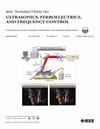First-Order Speckle Statistics for the Detection of Microstructural Anisotropy
IF 3.7
2区 工程技术
Q1 ACOUSTICS
IEEE transactions on ultrasonics, ferroelectrics, and frequency control
Pub Date : 2025-04-21
DOI:10.1109/TUFFC.2025.3562784
引用次数: 0
Abstract
Speckle statistics estimation is a useful quantitative ultrasound tool for characterizing tissue microstructure. However, because of their elongated geometry, fibrillar tissue components like collagen may not be described well by speckle statistics models. The purpose of this study is to perform a systematic analysis of the effects of microstructural anisotropy on speckle statistics estimation. We created phantoms made of wool fibers to correlate speckle statistics estimates to elongated scatterer geometries. Phantoms were attached to a calibrated spring to induce fiber alignment by applying a known tension. Ultrasonic beams were steered to 0°, ± 5°, and ± 10°. Nakagami and homodyned K distribution parameters were calculated from each steered acquisition. Applying tension (0–用于显微结构各向异性检测的一阶散斑统计。
斑点统计估计是一种有用的定量超声表征组织微观结构的工具。然而,由于其细长的几何形状,胶原蛋白等纤维组织成分可能无法用斑点统计模型很好地描述。本研究旨在系统分析微观结构各向异性对散斑统计估计的影响。我们用羊毛纤维制造了幽灵,将斑点统计估计与拉长的散射几何形状联系起来。幻影附着在一个校准的弹簧上,通过施加已知的张力来诱导纤维对齐。超声波光束被引导到0度、±5度和±10度。从每次定向采集中计算出Nakagami和homodyned K分布参数。施加张力(0至3±0.2 N)诱导羊毛纤维的对准,使得斑点统计估计显示出对光束转向角的依赖性增加。与0度估计相比,各向同性散射体在所有转向角上的Nakagami m、Nakagami Ω、同向K α和同向K K指标(分别)的变化分别为4%、55%、25%和17%,而在羊毛纤维体中观察到的变化分别为35%、177%、151%和23%。同样的实验在人类跟腱(28%,190%,140%和53%)和恒河猴子宫颈(9%,76%,58%和11%)中重复进行,以证明体内敏感性。本研究展示了如何使用散斑统计参数来测量各向异性声散射体的对准程度,而不是空间密度。
本文章由计算机程序翻译,如有差异,请以英文原文为准。
求助全文
约1分钟内获得全文
求助全文
来源期刊
CiteScore
7.70
自引率
16.70%
发文量
583
审稿时长
4.5 months
期刊介绍:
IEEE Transactions on Ultrasonics, Ferroelectrics and Frequency Control includes the theory, technology, materials, and applications relating to: (1) the generation, transmission, and detection of ultrasonic waves and related phenomena; (2) medical ultrasound, including hyperthermia, bioeffects, tissue characterization and imaging; (3) ferroelectric, piezoelectric, and piezomagnetic materials, including crystals, polycrystalline solids, films, polymers, and composites; (4) frequency control, timing and time distribution, including crystal oscillators and other means of classical frequency control, and atomic, molecular and laser frequency control standards. Areas of interest range from fundamental studies to the design and/or applications of devices and systems.

 求助内容:
求助内容: 应助结果提醒方式:
应助结果提醒方式:


